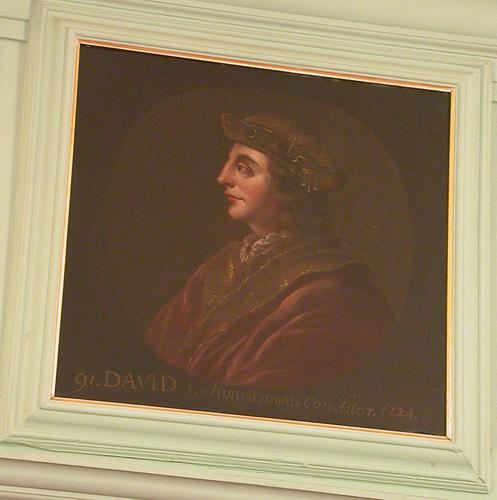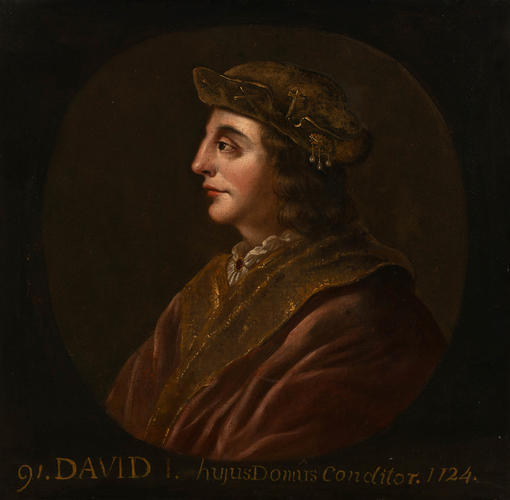David I, King of Scotland (1124-53) 1684-86
Oil on canvas | 79.0 x 81.0 cm (support, canvas/panel/stretcher external) | RCIN 403281
-
This portrait of David I is presented within a painted oval, in profile, facing the left. De Wet has portrayed the monarch wearing a brown coat and a cap with a matching collar.
This portrait is one of ninety-three bust-lengths commissioned to decorate the Great Gallery at Holyroodhouse, Edinburgh. It is painted by Jacob de Wet II, a Dutch artist working in Scotland from 1673. Together with eighteen full-lengths these portraits illustrate the genealogy of the royal house of Scotland from Fergus I (who ascended the throne in 330 BC) to James VII (who abdicated in 1689). De Wet’s iconographic scheme was based on well-known chronicles of Scottish history by the Renaissance humanists Hector Boece (Scotorum Historiae, 1527) and George Buchanan (Rerum Scoticarum Historia, 1582). The inscriptions on the paintings correspond with Buchanan’s list of Scottish kings: from left to right, these are the number and name of the king followed by the date of accession. The dates however are considerably muddled, by a later restorer or perhaps even the artist himself.
Both real and legendary, their purpose was to proclaim the authority of the Stuarts as divinely appointed rulers of Scotland. Commissioned and paid for by the Scottish Privy Council, the series was intended to convey the power and greatness of the country’s governing body as much as that of their king. With no authentic likenesses on which to base his portraits of medieval kings, de Wet made extensive use of an earlier set by the Scottish artist George Jamesone, of which twenty-six survive in private collections. From this limited basis the resulting series appears rather repetitious. Much more important than their aesthetic merit therefore was the symbolic power of painting an extremely long royal lineage stretching more than two millennia.
In the original contract David I is listed as one of the select few kings of Scotland to be depicted full-length. In his place is the legendary founder of the Scottish Church Donald I (403329), who apparently introduced coinage to the realm. David I was undoubtedly one of Scotland’s greatest kings. A pioneering ecclesiastical reformer, he founded many monasteries and abbeys including – most significantly for this series – Holy Rood Abbey in Edinburgh, whose ruins directly flank the modern Baroque palace. Either de Wet confused his orders or his patrons changed their minds: whatever the reason, the absence of David’s full-length portrait from the series would have perplexed visitors to Holyrood in the 17th century.
Number 91 in the series. Inscribed DAVID I. HUJUS DOMUS CONDITOR (builder of this house). 1124.
Provenance
Commissioned by the Scottish Privy Council in the name of Charles II
-
Medium and techniques
Oil on canvas
Measurements
79.0 x 81.0 cm (support, canvas/panel/stretcher external)
Category
Object type(s)
Other number(s)
OM add-de WetAlternative title(s)
David I, King of Scotland (reign 1124-1153)
David I Hujus Domus Conditor









